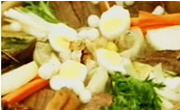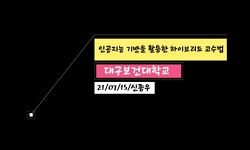宋元話本小說 ‘篇尾’에는 다양한 ‘修辭格’이 운용되고 있는데, 이러한 修辭格의 표현을 통해수사 예술의 뛰어난 성과를 살펴볼 수 있다. ‘篇尾’에 운용된 ‘修辭格’은 어문의 기세...
http://chineseinput.net/에서 pinyin(병음)방식으로 중국어를 변환할 수 있습니다.
변환된 중국어를 복사하여 사용하시면 됩니다.
- 中文 을 입력하시려면 zhongwen을 입력하시고 space를누르시면됩니다.
- 北京 을 입력하시려면 beijing을 입력하시고 space를 누르시면 됩니다.

宋元話本小說 ‘篇尾’에 나타난 수사학적 표현예술의 의미 연구 = Study on Semantics of Rhetorical Style Expressional Arts in 'Pyunmi (篇尾)' of Sung Yuan's Hua-Ben Novels
한글로보기https://www.riss.kr/link?id=A101822987
- 저자
- 발행기관
- 학술지명
- 권호사항
-
발행연도
2016
-
작성언어
-
-
주제어
송원화본소설 ; 편미 ; 수사격 ; 설문 ; 대구 ; 첩자 ; 宋元話本小說 ; 篇尾 ; 修辭格 ; 說問 ; 對偶 ; 疊字 ; Sung Yuan's Hua-Ben Novels ; Pyunmi ; Rhetorical Style ; Questionnaire ; Daewoo ; Overlapped Character
-
KDC
820
-
등재정보
KCI등재
-
자료형태
학술저널
- 발행기관 URL
-
수록면
1-22(22쪽)
-
KCI 피인용횟수
0
- DOI식별코드
- 제공처
-
0
상세조회 -
0
다운로드
부가정보
국문 초록 (Abstract)
宋元話本小說 ‘篇尾’에는 다양한 ‘修辭格’이 운용되고 있는데, 이러한 修辭格의 표현을 통해수사 예술의 뛰어난 성과를 살펴볼 수 있다. ‘篇尾’에 운용된 ‘修辭格’은 어문의 기세와 독자의 인상을 강조하거나, 혹은 작품 내용을 응집하고 정련하면서 간단하고 정제된 방식을 유지하기 위해서거나, 또는 어문 형식을 응용하여 서술적 흐름에 변화와 조화를 구현하는 등의예술적 의미를 지닌다. 이러한 수사 예술의 의미를 고찰하는 것은 먼저 서술자에 대한 감정과 견해, 주장과 생각을 폭넓게 이해할 수 있는 시각을 제시하며, 이어서 작품 내용에 대한직접적이고 적극적인 이해를 도와주는데 중요한 역할을 담당하고 있다. 또한 당시 話本小說에 나타난 다양한 수사 기교를 통해 小說修辭學의 미학적 관점과 표현 예술의 구현 과정을 자세히 살펴볼 수 있다. 宋元話本小說 ‘篇尾’에 나타난 수사 기교와 예술적 성취는 상당히 체계적이고 숙성된 것이라고 할 수 있다. 이것은 청자(독자)를 주요한 대상으로 그들에게 가장효과적이고 직접적인 방식으로 예술적 감흥을 전달하는 법을 강구하는 것이며, 동시에 작가자신의 미적 감각을 ‘修辭格’의 운용을 통해 적극적으로 발현하는 것으로 볼 수 있다. 작가는작품에 대한 내용과 형식, 주제와 의미에 대한 예술적 안배와 조정을 ‘篇尾’를 통해 적절하게표현하고 있으며, 또한 청자(독자)에게 효과적이고 적확하게 작품의 내용과 주제를 종결하거나 정리하여 전달하고 있다.
다국어 초록 (Multilingual Abstract)
Sung Yuan's Hua-ben Novels (宋元話本小說) ‘Pyunmi (篇尾)’ has various ‘rhetoricalstyle (修辭格)’. Through the expression of this rhetorical style (修辭格), an excellentachievement of rhetorical art could be investigated. The arti...
Sung Yuan's Hua-ben Novels (宋元話本小說) ‘Pyunmi (篇尾)’ has various ‘rhetoricalstyle (修辭格)’. Through the expression of this rhetorical style (修辭格), an excellentachievement of rhetorical art could be investigated. The artistic meaning of'rhetorical style (修辭格)' used in ‘Pyunmi (篇尾)’ intends to emphasize the spirit ofphrase and the reader's impression or maintain a simple and refined method whilecondensing and refining the content of the work, or realize change andharmonization in the narrative stream by applying the phrase form. To considersuch meaning of rhetorical art, firstly, it suggests the view to widely understandthe emotion, opinion, insistence, and thought on the narrator. Subsequently, ittakes an important role in helping direct and active understanding of the contentof the work. Also, aesthetic viewpoint of novel rhetorical style through variousrhetorical technique in Hua-Ben Novels (話本小說) of that period and realizationprocess of expressional arts could be concretely investigated. Rhetorical techniqueand artistic achievement in Sung Yuan's Hua-Ben Novels (宋元話本小說) ‘Pyunmi (篇尾)’ can be said to be quite systematic and mature. This is to devise a method todeliver the artistic inspiration to them in the most effective and direct method,mainly targeting the audience (reader), at the same time, actively reveal the writer'sown aesthetic sense through the operation of ‘rhetorical style (修辭格)’. The writerproperly expressed artistic arrangement and adjustment on the content, form,subject, and significance of the work through ‘Pyunmi (篇尾)’ as well as deliveredthe content and the subject of the work to the audience (reader) by effectivelyand precisely concluding or arranging them.
목차 (Table of Contents)
- 초록
- 1. 들어가는 말
- 2. 宋元話本小說 ‘篇尾’에 운용된 ‘修辭格’의 분류와 특징
- 3. 宋元話本小說 ‘篇尾’에 운용된 ‘修辭格’의 예술적 의미
- 1) 어문의 기세와 독자의 인상을 강조 : ‘映襯’, ‘設問’
- 초록
- 1. 들어가는 말
- 2. 宋元話本小說 ‘篇尾’에 운용된 ‘修辭格’의 분류와 특징
- 3. 宋元話本小說 ‘篇尾’에 운용된 ‘修辭格’의 예술적 의미
- 1) 어문의 기세와 독자의 인상을 강조 : ‘映襯’, ‘設問’
- 2) 내용의 응집과 정제된 방식 : ‘引用’, ‘對偶’
- 3) 어문 형식의 응용과 변화 : ‘類疊’, ‘列錦’
- 4. 나오는 말
- 참고문헌
- 논문초록
참고문헌 (Reference)
1 이치수, "陸游 詞의 對比 修辭法" 영남중국어문학회 (57) : 27-52, 2011
2 진영, "판소리계 소설과 화본소설의 비교연구" 경희대학교 대학원 2009
3 馮夢龍, "醒世桓言" 三民書局 1995
4 馮夢龍, "警世通言" 三民書局 1992
5 胡士瑩, "話本小說槪論" 中華書局 1980
6 신은경, "話本小說 「刎頸鴛鴦會」에 대한 비교문학적 연구" 한국비교문학회 (51) : 301-326, 2010
7 金明求, "虛實空間的移轉與流動 ― 宋元話本小說的空間探討" 大安出版社 2002
8 熊龍峰, "熊龍峰刊行小說四種" 江蘇古籍出版社 1994
9 漢語大詞典編輯委員會, "漢語大詞典 第9卷" 漢語大詞典出版社 1994
10 洪楩, "清平山堂話本" 江蘇古籍出版社 1994
1 이치수, "陸游 詞의 對比 修辭法" 영남중국어문학회 (57) : 27-52, 2011
2 진영, "판소리계 소설과 화본소설의 비교연구" 경희대학교 대학원 2009
3 馮夢龍, "醒世桓言" 三民書局 1995
4 馮夢龍, "警世通言" 三民書局 1992
5 胡士瑩, "話本小說槪論" 中華書局 1980
6 신은경, "話本小說 「刎頸鴛鴦會」에 대한 비교문학적 연구" 한국비교문학회 (51) : 301-326, 2010
7 金明求, "虛實空間的移轉與流動 ― 宋元話本小說的空間探討" 大安出版社 2002
8 熊龍峰, "熊龍峰刊行小說四種" 江蘇古籍出版社 1994
9 漢語大詞典編輯委員會, "漢語大詞典 第9卷" 漢語大詞典出版社 1994
10 洪楩, "清平山堂話本" 江蘇古籍出版社 1994
11 凌濛初, "拍案驚奇" 三民書局 1995
12 김명구, "惡性과 善性 사이 ― ≪三言≫ 속에 나타난 ‘善惡竝存’ 인물 연구" 중국어문연구회 (69) : 229-267, 2015
13 樂蘅軍, "宋代話本硏究" 國立臺灣大學出版委員會 1969
14 馮夢龍, "喻世明言" 三民書局 1998
15 成偉鈞, "修辭通鑑" 建宏出版社 1996
16 陳介白, "修辭學講話, 修辭學硏究 內" 信誼書局 1978
17 陳望道, "修辭學發凡" 上海書店 1990
18 黃慶萱, "修辭學" 三民書局 2002
19 凌濛初, "二刻拍案驚奇" 三民書局 1993
20 백승엽, "《청평산당화본》의 구연체제 및 언술구조 연구" 단국대학교 대학원 2001
동일학술지(권/호) 다른 논문
-
- 대한중국학회
- 신가림(JiaLin Shen)
- 2016
- KCI등재
-
- 대한중국학회
- 최낙민(NackMin Choi)
- 2016
- KCI등재
-
- 대한중국학회
- 최형섭(HyoungSeob Choi)
- 2016
- KCI등재
-
- 대한중국학회
- 주준영(JunYong Joo)
- 2016
- KCI등재
분석정보
인용정보 인용지수 설명보기
학술지 이력
| 연월일 | 이력구분 | 이력상세 | 등재구분 |
|---|---|---|---|
| 2026 | 평가예정 | 재인증평가 신청대상 (재인증) | |
| 2020-01-01 | 평가 | 등재학술지 유지 (재인증) |  |
| 2017-01-01 | 평가 | 등재학술지 유지 (계속평가) |  |
| 2014-01-01 | 평가 | 등재학술지 선정 (계속평가) |  |
| 2013-01-01 | 평가 | 등재후보 1차 PASS (등재후보1차) |  |
| 2012-01-01 | 평가 | 등재후보학술지 유지 (기타) |  |
| 2011-01-01 | 평가 | 등재후보학술지 유지 (등재후보2차) |  |
| 2010-01-01 | 평가 | 등재후보 1차 PASS (등재후보1차) |  |
| 2009-01-01 | 평가 | 등재후보학술지 유지 (등재후보2차) |  |
| 2008-01-01 | 평가 | 등재후보 1차 PASS (등재후보1차) |  |
| 2006-01-01 | 평가 | 등재후보학술지 선정 (신규평가) |  |
학술지 인용정보
| 기준연도 | WOS-KCI 통합IF(2년) | KCIF(2년) | KCIF(3년) |
|---|---|---|---|
| 2016 | 0.28 | 0.28 | 0.3 |
| KCIF(4년) | KCIF(5년) | 중심성지수(3년) | 즉시성지수 |
| 0.29 | 0.27 | 0.439 | 0.16 |




 KCI
KCI 스콜라
스콜라






